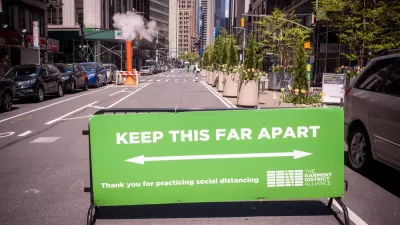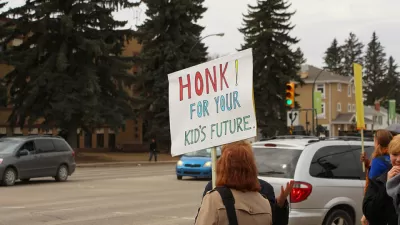In the middle of presidential primary season, the debate about the caucus vs. primary processes is hot with criticisms being leveled on both sides. What can planners learn about this debate to help improve community engagement for planning?

Half way through the presidential nomination process, it's hard to avoid the onslaught of media coverage about the primaries. A recent visit to Seattle one day before the Democratic caucus in Washington State stirred up plenty of conversations about the process. As a community engagement professional and having never lived in a state that held caucuses, I found the conversations to be extremely enlightening. I also couldn't help but notice several parallels with community engagement for planning projects.
The process of nominating a presidential candidate to represent the party in the general election is complicated. While there are many varieties, here's a high level overview. States either hold primaries or caucuses. Caucuses are used in only 13 states and two U.S. territories. Primaries make up the rest and thus are used in the majority of states. A primary is much like a typical election with people going to a polling place and casting a secret or private vote. Depending on the line-ups, the process could take a few minutes or as much as several hours. Caucuses, on the other hand, are public meetings in which the candidates or their representatives are present and registered party members gather to discuss the pros and cons of the candidates at length and vote publicly, typically either by show of hands or moving around the room. Several votes may be taken and if people remain undecided their peers have an opportunity to discuss the issues with them further to help them reach a conclusion.
In Seattle, as I was learning more about what happens in a caucus meeting, my first reaction was excitement. I thought about how it has become politically incorrect to talk about politics in public and how that has all but eliminated a historically important learning process. I thought about how, in the absence of much open public discourse, people must be relying on increasingly brief news clips, commercials, Facebook updates, and tweets to learn about the issues and the candidates. I thought how great it was that people were required to discuss the pros and cons of each of the candidates before voting in the caucus. I thought about the value of hearing alternative points of view and debating with neighbors before voting.
This excitement was short-lived. I learned about the low turnouts and the narrow demographic that attend caucus meetings. I learned about the difficulties associated with being required to vote in public. I heard from people who felt awkward voting publicly after hearing their neighbor's impassioned pleas for a candidate they opposed. The parallels with community engagement for planning projects became clear.
It didn't take long to find published criticisms of the caucus process. In a 2010 Fordham University study titled "Are Caucuses Bad for Democracy," the researchers found that the views of primary voters "better resemble those of the general public" than do the views of caucus voters. They found that that caucus participation is skewed in favor of males and people with higher levels of education. The study concluded that replacing caucuses with primaries would result in slightly more accurate “demographic and attitudinal representation.”
Critics like this Boston Globe writer are calling caucuses outdated and pointing out that, “Voters who aren't physically able to sit in a school gymnasium and debate the merits of their candidate with their neighbors get shut out.”
Caucuses are getting rarer. This election cycle saw the Republicans in Washington State move from a caucus to a primary process. The Democrats in Washington State held on to the caucus process for now but the downward trend is clear.
There are several parallels with community engagement processes for planning projects. Traditional community meetings, like caucuses, often require people to spend a few hours and provide an open forum for participants to discuss the planning options and priorities. They too are criticized for poor turnouts and attracting a narrow demographic. Increasingly, less time consuming and more accessible options are being added to planner’s community engagement toolbox. Many of these options such as open house drop in sessions, online engagement tools, and pop-up engagement events require less time to participate and give people the flexibility to choose an option that fits their needs.
Being focused as I am on best practices for community engagement, the question I turned to is this: how can we preserve as much of what's great about the dialogue and deliberation that occurs in public meetings while mitigating the trade-offs. I'll be digging into this question in future posts and we will continue to look at case studies through the Fiasco Files. For now, some ideas that were offered in discussions in Seattle and in the corridors of APA 2016 included:
- Encouraging open and respectful dialogue and discussion between participants wherever possible,
- Using keypad polling in public meetings to mitigate the possibility of intimidation,
- Offering more face to face options that are less time consuming than sit down public meetings,
- Offering a rich & educational online engagement option that highlights the pros, cons and trade-offs of options, and
- Using video and forums to convey alternative viewpoints when synchronous dialog isn't possible.
Caucuses may prove to be the less democratic choice, especially if they are the only option for people to participate. The same can be said for community meetings for a planning project. If we rely solely on input gathered at public meetings we suffer from the same criticisms that face caucuses. We face complex choices in both community planning and politics and we need to enhance, not diminish, opportunities for public dialogue, deliberation and education. It would be a great step forward for the democracy of both if we could achieve this without unfairly limiting participation for any members of the community.
Simply switching from a caucus to a primary isn't a silver bullet. The primaries have had their share of criticisms as well with long lines, broken voting machines and more. Similarly, switching from community meetings to a multiple choice online survey for community engagement in a planning project isn't a silver bullet either. The answer is more nuanced and my hope is that we will continue to evolve both in the spirit of improving the democratic process of all public decision making.
It's a tall order. Based on my conversations in Seattle as well as at APA 2016, it's a dialogue that many are anxious to see happen.

Alabama: Trump Terminates Settlements for Black Communities Harmed By Raw Sewage
Trump deemed the landmark civil rights agreement “illegal DEI and environmental justice policy.”

Study: Maui’s Plan to Convert Vacation Rentals to Long-Term Housing Could Cause Nearly $1 Billion Economic Loss
The plan would reduce visitor accommodation by 25% resulting in 1,900 jobs lost.

Planetizen Federal Action Tracker
A weekly monitor of how Trump’s orders and actions are impacting planners and planning in America.

Waymo Gets Permission to Map SF’s Market Street
If allowed to operate on the traffic-restricted street, Waymo’s autonomous taxis would have a leg up over ride-hailing competitors — and counter the city’s efforts to grow bike and pedestrian on the thoroughfare.

Parklet Symposium Highlights the Success of Shared Spaces
Parklets got a boost during the Covid-19 pandemic, when the concept was translated to outdoor dining programs that offered restaurants a lifeline during the shutdown.

Federal Homelessness Agency Places Entire Staff on Leave
The U.S. Interagency Council on Homelessness is the only federal agency dedicated to preventing and ending homelessness.
Urban Design for Planners 1: Software Tools
This six-course series explores essential urban design concepts using open source software and equips planners with the tools they need to participate fully in the urban design process.
Planning for Universal Design
Learn the tools for implementing Universal Design in planning regulations.
Caltrans
Smith Gee Studio
Institute for Housing and Urban Development Studies (IHS)
City of Grandview
Harvard GSD Executive Education
Toledo-Lucas County Plan Commissions
Salt Lake City
NYU Wagner Graduate School of Public Service






























